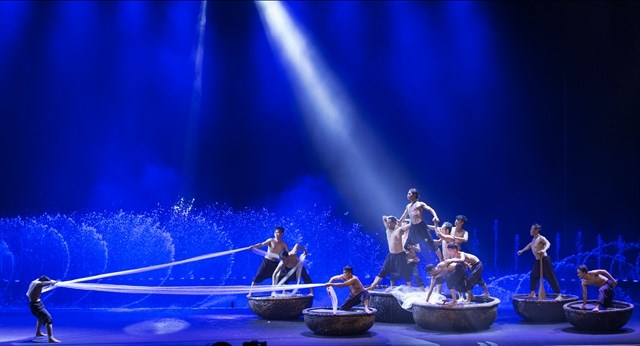 |
|
A scene at the Fisherman Show (Photo courtesy of the museum) |
Present in every Vietnamese home, fish sauce has been closely tied to thecountry's culinary and cultural customs for three centuries.
“I want to restore the brand name of Nuoc Mam Tin (Fish Sauce in PotteryJars),” said Dung, who grew up in Binh Hung fishing village in Phan Thiet city.
His family once made traditional fish sauce in Phan Thiet, located in thesouth-central coastal province of Binh Thuan.
Known as the cradle of fish-sauce making in the country, the city has beenproducing the amber salty liquid since the early 18th century.
To revive the old traditions, Dung has opened a fish sauce museum and an artperformance dedicated to the craft.
In the old days, the sauce was brewed in large wooden vats and then poured intopottery jars for boat transport on the local Ca Ty River to all corners of thecountry.
“Storing the fish sauce in these jars preserved the aroma and taste for a longtime and made it more delicious,” Dung said.
At that time, the fish sauce industry was so active that many producers becamerich and donated money to build streets in the city.
After the end of the war in 1975, however, the industry began to decline.
The pottery jars were no longer available in the market and the producers'prosperous days were suddenly over .
However, today, the traditional fish sauce industry in Phan Thiet accounts for20 percent of market share of all fish sauce produced in the country.
In 2016, the Binh Thuan provincial People's Committee approved Dung's culturalproject called Old Fishing Village. Dung invested nearly 100 billion VND (4.2million USD) in the project.
Construction on the museum began the next year and was completed in May.
Returning home
In 1993, when Dung scored the highest mark on the entrance exam to Ho Chi Minh CityUniversity of Economics, he received a scholarship to study for a bachelor'sdegree in Australia. After that, he earned a doctorate in behaviour andpsychological research in France.
Then he returned to HCM City and founded a market research company. After 10years of success, he sold it and returned to Phan Thiet.
Dung said his experiences abroad exposed him to many different cultures andmuseums. During his years abroad and business trips to other countries, helearned that local cultural values and modern performances could become touristattractions.
“I visited museums and cultural shows in many countries,” he said.
However, attracting investment to cultural projects is difficult because theprofits are not high. “But my passion allowed me to be patient," he said.
For his project in Phan Thiet, he first developed the Fisherman Show, which isabout a Vietnamese Kinh fisherman and ethnic Cham woman.
The show features local customs and culture such as dances that respect theShiva God at Poshanu Tower, highlights of the Kate festival of the Cham and theGod of Whales festival with a traditional praying song at Van Thuy Tu temple.
Professional contemporary dancers perform and local musicians play traditionalinstruments and sing on a four-storey stage with water effects, flyingequipment, LED screens, flying sand dunes, oxen and carts.
To understand the stories in the show, tourists can first visit the fish saucemuseum located nearby.
An eight-minute video explains to visitors the development of Phan Thiet and Mui Ne village, a well-known beach resort in the area, and the local fishingvillage.
A painting of boats on Ca Ty River and a water tower, a symbol of the Phan Thiet,is next on the tour.
Visitors can also enjoy 14 3D interactive exhibits featuring photos and itemsfrom the city's past.
The museum, which covers 2,000 square metres, displays a small replica ofPoshanu tower, real sand, leaf-made houses, an ancient house of an aristocraticfamily whose wealth was made from fish sauce, and miniature salt fields.
Wooden vats and pottery jars used to store fish sauce are also on display aswell as information about how the sauce is made.
In a five-minute video, the Cham’s famous technique of brewing fish sauce isdemonstrated.
Stalls in the museum also offer pure traditional fish sauce, called Nuoc Mam Tin, to visitors who want to sample the old recipe.
During the project's launch ceremony, Ngo Minh Chinh, director of theprovince's Department of Culture, Sport and Tourism, pointed out that Dung'sproject could help Vietnamese, particularly youth, and foreigners learn morelocal culture and traditional fish sauce.
The project has contributed to a better understanding of the 300-year historyof fish sauce, and many people like to buy it as a souvenir, according to Dung.
Since the museum's opening, the number of visitors has increased from 200,000to 400,000. It aims to attract one million tourists by 2020 and three millionin 2025.
“If we have models of good cooperation, tourism can help trade villagesdevelop,” Dung said.- VNS
 For Tran Ngoc Dung, the traditional fish sauce of Vietnam has not received the respect it deserves.
For Tran Ngoc Dung, the traditional fish sauce of Vietnam has not received the respect it deserves.